8.8E:练习
- Page ID
- 203974
\( \newcommand{\vecs}[1]{\overset { \scriptstyle \rightharpoonup} {\mathbf{#1}} } \) \( \newcommand{\vecd}[1]{\overset{-\!-\!\rightharpoonup}{\vphantom{a}\smash {#1}}} \)\(\newcommand{\id}{\mathrm{id}}\) \( \newcommand{\Span}{\mathrm{span}}\) \( \newcommand{\kernel}{\mathrm{null}\,}\) \( \newcommand{\range}{\mathrm{range}\,}\) \( \newcommand{\RealPart}{\mathrm{Re}}\) \( \newcommand{\ImaginaryPart}{\mathrm{Im}}\) \( \newcommand{\Argument}{\mathrm{Arg}}\) \( \newcommand{\norm}[1]{\| #1 \|}\) \( \newcommand{\inner}[2]{\langle #1, #2 \rangle}\) \( \newcommand{\Span}{\mathrm{span}}\) \(\newcommand{\id}{\mathrm{id}}\) \( \newcommand{\Span}{\mathrm{span}}\) \( \newcommand{\kernel}{\mathrm{null}\,}\) \( \newcommand{\range}{\mathrm{range}\,}\) \( \newcommand{\RealPart}{\mathrm{Re}}\) \( \newcommand{\ImaginaryPart}{\mathrm{Im}}\) \( \newcommand{\Argument}{\mathrm{Arg}}\) \( \newcommand{\norm}[1]{\| #1 \|}\) \( \newcommand{\inner}[2]{\langle #1, #2 \rangle}\) \( \newcommand{\Span}{\mathrm{span}}\)\(\newcommand{\AA}{\unicode[.8,0]{x212B}}\)
练习成就完美
在以下练习中,评估每个函数。
- \(f(x)=\sqrt{4 x-4}\),找到
- \(f(5)\)
- \(f(0)\)
- \(f(x)=\sqrt{6 x-5}\),找到
- \(f(5)\)
- \(f(-1)\)
- \(g(x)=\sqrt{6 x+1}\),找到
- \(g(4)\)
- \(g(8)\)
- \(g(x)=\sqrt{3 x+1}\),找到
- \(g(8)\)
- \(g(5)\)
- \(F(x)=\sqrt{3-2 x}\),找到
- \(F(1)\)
- \(F(-11)\)
- \(F(x)=\sqrt{8-4 x}\),找到
- \(F(1)\)
- \(F(-2)\)
- \(G(x)=\sqrt{5 x-1}\),找到
- \(G(5)\)
- \(G(2)\)
- \(G(x)=\sqrt{4 x+1}\),找到
- \(G(11)\)
- \(G(2)\)
- \(g(x)=\sqrt[3]{2 x-4}\),找到
- \(g(6)\)
- \(g(-2)\)
- \(g(x)=\sqrt[3]{7 x-1}\),找到
- \(g(4)\)
- \(g(-1)\)
- \(h(x)=\sqrt[3]{x^{2}-4}\),找到
- \(h(-2)\)
- \(h(6)\)
- \(h(x)=\sqrt[3]{x^{2}+4}\),找到
- \(h(-2)\)
- \(h(6)\)
- 对于该函数\(f(x)=\sqrt[4]{2 x^{3}}\),请找到
- \(f(0)\)
- \(f(2)\)
- 对于该函数\(f(x)=\sqrt[4]{3 x^{3}}\),请找到
- \(f(0)\)
- \(f(3)\)
- 对于该函数\(g(x)=\sqrt[4]{4-4 x}\),请找到
- \(g(1)\)
- \(g(-3)\)
- 对于该函数\(g(x)=\sqrt[4]{8-4 x}\),请找到
- \(g(-6)\)
- \(g(2)\)
- 回答
-
1。
- \(f(5)=4\)
- 此处没有价值\(x=0\)
3。
- \(g(4)=5\)
- \(g(8)=7\)
5。
- \(F(1)=1\)
- \(F(-11)=5\)
7。
- \(G(5)=2 \sqrt{6}\)
- \(G(2)=3\)
9。
- \(g(6)=2\)
- \(g(-2)=-2\)
11。
- \(h(-2)=0\)
- \(h(6)=2 \sqrt[3]{4}\)
13。
- \(f(0)=0\)
- \(f(2)=2\)
15。
- \(g(1)=0\)
- \(g(-3)=2\)
在以下练习中,找到函数的域,然后用区间表示法写下该域。
- \(f(x)=\sqrt{3 x-1}\)
- \(f(x)=\sqrt{4 x-2}\)
- \(g(x)=\sqrt{2-3 x}\)
- \(g(x)=\sqrt{8-x}\)
- \(h(x)=\sqrt{\frac{5}{x-2}}\)
- \(h(x)=\sqrt{\frac{6}{x+3}}\)
- \(f(x)=\sqrt{\frac{x+3}{x-2}}\)
- \(f(x)=\sqrt{\frac{x-1}{x+4}}\)
- \(g(x)=\sqrt[3]{8 x-1}\)
- \(g(x)=\sqrt[3]{6 x+5}\)
- \(f(x)=\sqrt[3]{4 x^{2}-16}\)
- \(f(x)=\sqrt[3]{6 x^{2}-25}\)
- \(F(x)=\sqrt[4]{8 x+3}\)
- \(F(x)=\sqrt[4]{10-7 x}\)
- \(G(x)=\sqrt[5]{2 x-1}\)
- \(G(x)=\sqrt[5]{6 x-3}\)
- 回答
-
1。 \(\left[\frac{1}{3}, \infty\right)\)
3。 \(\left(-\infty, \frac{2}{3}\right]\)
5。 \((2, \infty)\)
7。 \((-\infty,-3] \cup(2, \infty)\)
9。 \((-\infty, \infty)\)
11。 \((-\infty, \infty)\)
13。 \(\left[-\frac{3}{8}, \infty\right)\)
15。 \((-\infty, \infty)\)
在以下练习中,
- 找到函数的域
- 绘制函数图
- 使用图表确定范围
- \(f(x)=\sqrt{x+1}\)
- \(f(x)=\sqrt{x-1}\)
- \(g(x)=\sqrt{x+4}\)
- \(g(x)=\sqrt{x-4}\)
- \(f(x)=\sqrt{x}+2\)
- \(f(x)=\sqrt{x}-2\)
- \(g(x)=2 \sqrt{x}\)
- \(g(x)=3 \sqrt{x}\)
- \(f(x)=\sqrt{3-x}\)
- \(f(x)=\sqrt{4-x}\)
- \(g(x)=-\sqrt{x}\)
- \(g(x)=-\sqrt{x}+1\)
- \(f(x)=\sqrt[3]{x+1}\)
- \(f(x)=\sqrt[3]{x-1}\)
- \(g(x)=\sqrt[3]{x+2}\)
- \(g(x)=\sqrt[3]{x-2}\)
- \(f(x)=\sqrt[3]{x}+3\)
- \(f(x)=\sqrt[3]{x}-3\)
- \(g(x)=\sqrt[3]{x}\)
- \(g(x)=-\sqrt[3]{x}\)
- \(f(x)=2 \sqrt[3]{x}\)
- \(f(x)=-2 \sqrt[3]{x}\)
- 回答
-
1。
- 域:\([-1, \infty)\)
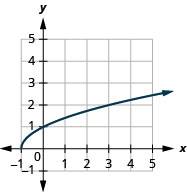
图 8.7.8- \([0, \infty)\)
3。
- 域:\([-4, \infty)\)
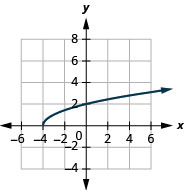
图 8.7.9- \([0, \infty)\)
5。
- 域:\([0, \infty)\)
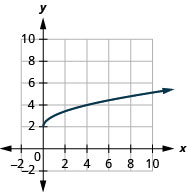
图 8.7.10- \([2, \infty)\)
7。
- 域:\([0, \infty)\)

图 8.7.11- \([0, \infty)\)
9。
- 域:\((-\infty, 3]\)
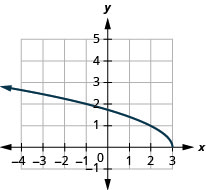
图 8.7.12- \([0, \infty)\)
11。
- 域:\([0, \infty)\)
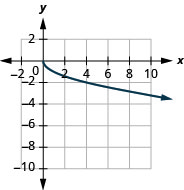
图 8.7.13- \((-\infty, 0]\)
13。
- 域:\((-\infty, \infty)\)
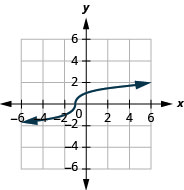
图 8.7.14- \((-\infty, \infty)\)
15。
- 域:\((-\infty, \infty)\)
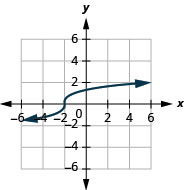
图 8.7.15- \((-\infty, \infty)\)
17。
- 域:\((-\infty, \infty)\)
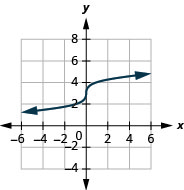
图 8.7.16- \((-\infty, \infty)\)
19。
- 域:\((-\infty, \infty)\)
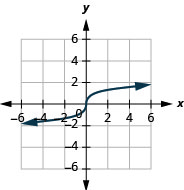
图 8.7.17- \((-\infty, \infty)\)
21。
- 域:\((-\infty, \infty)\)
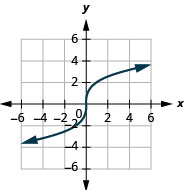
图 8.7.18- \((-\infty, \infty)\)
- 解释如何找到第四个根函数的域。
- 解释如何找到第五个根函数的域。
- 解释为什么\(y=\sqrt[3]{x}\)是函数。
- 解释为什么查找具有偶数索引的激进函数的域的过程与索引为奇数时的过程不同。
- 回答
-
1。 答案可能有所不同
3。 答案可能有所不同
自检
a. 完成练习后,使用此清单评估您对本节目标的掌握程度。

b. 关于你对本部分的掌握程度,这份清单告诉了你什么? 你会采取哪些措施来改进?


